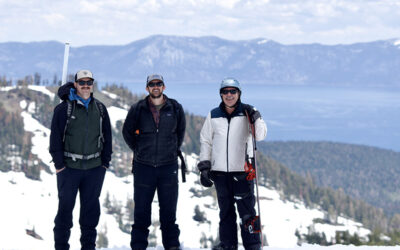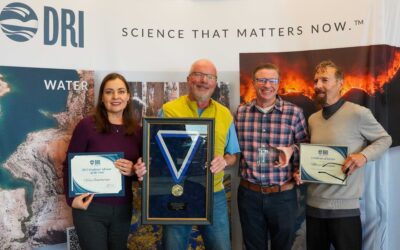Clouds – those enigmatic formations of condensed water vapor which drift above our heads, forming rivers in the sky – can take many forms. They can be wispy and non-threatening, dark and menacing, towering or diaphanous. We tend to think of them as beyond human reach, as harbingers of forces outside of our control, but as scientists learn more about them, it’s increasingly clear that humanity isn’t merely subjected to whatever weather a cloud portends – we also create and influence it through our everyday actions. And scientists now regularly harness their moisture and pull it to Earth, bringing water to parched communities and landscapes around the world.
This rain-inducing technique, called cloud-seeding, has been around for more than 60 years. The process involves “seeding” existing clouds with a harmless substance called silver-iodide to give water droplets a particle to converge around, allowing them to form an ice crystal. Every snowflake you’ve ever seen has initially formed this way – a small speck of dust or pollen floating around the atmosphere collects freezing drops of water, forming the intricate designs that we’re familiar with. The only difference between cloud-seeding and natural precipitation is that instead of dust or pollen, the nucleus of the ice crystal is a tiny particle of silver iodide that scientists released into the cloud. Although not a panacea for drought-stricken regions, cloud-seeding can increase seasonal precipitation by about 10%. In the Reno area alone, winter cloud-seeding efforts are estimated to add enough water to supply about 40,000 households for a year.
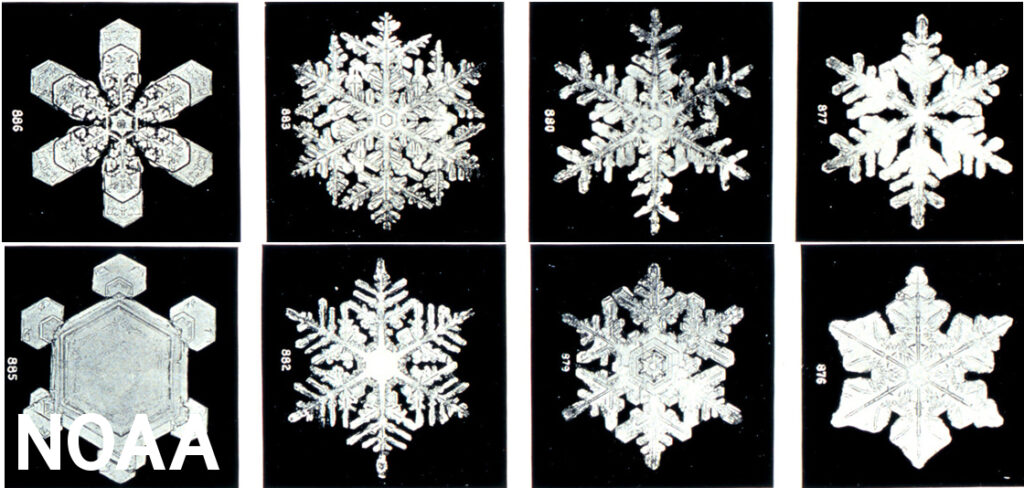
Microscopic view of snowflakes by Wilson Bentley. From the Annual Summary of the Monthly Weather Review for 1902. Bentley was a farmer whose hobby was photographing snowflakes. Source: NOAA Photo Library archives Weather Wonders collection, www.photolib.noaa.gov.
Credit: NOAA
DRI researchers first joined pioneering efforts to draw more precipitation from otherwise reluctant clouds in the early 1960s, using it to increase the mountain snowpacks that supply much of the West’s water. Today, our scientists continue cloud-seeding efforts around Nevada, including in the Sierra Nevada mountains near Reno, the Spring Mountains near Las Vegas, and the Ruby Mountains near Elko. To bolster the snowpack feeding the Colorado River, DRI runs additional cloud-seeding efforts in Colorado.
“I feel really passionate that we can improve water resources across the Western U.S. with these cloud-seeding programs,” said Frank McDonough, DRI’s cloud-seeding program director. “And we can run them relatively inexpensively. It’s really the only way to add precipitation to a watershed.”
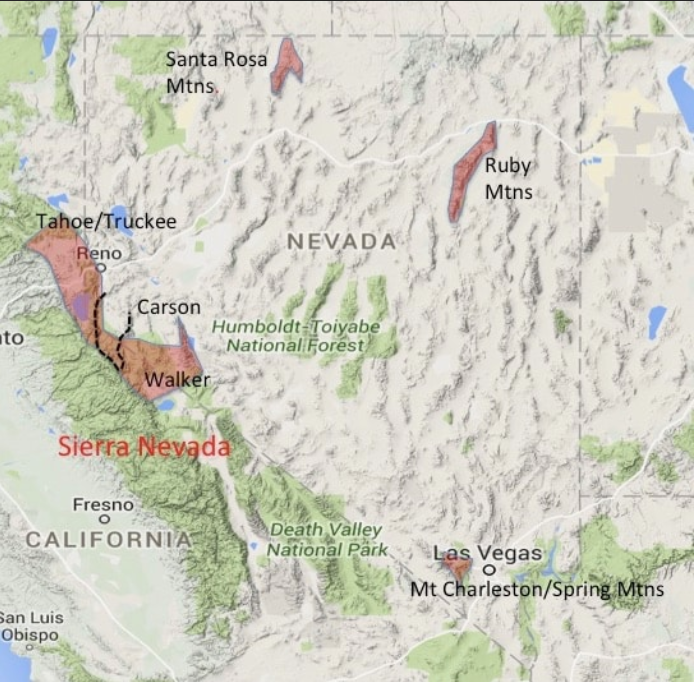
Above: A map of DRI’s cloud-seeding locations around Nevada. DRI also has operations in Colorado.
Cloud-seeding in a time of increasing drought
Nevada is the driest state in the nation, with the statewide precipitation average a mere 10.3 inches — only about a third of the nationwide average of 30 inches. The rest of the Western U.S. isn’t faring much better, as the 21st century has been a time with the most severe drought in 1,200 years.
Scientists examined tree rings to decipher the historical record for soil moisture across the region, finding that the years 2002 and 2021 were among the driest. Although historical records tell us the Western U.S. is prone to fluctuations in climate, the growing greenhouse effect of burning fossil fuels is exacerbating drying conditions. In 2022, DRI researchers published a study showing that as temperatures rise, the atmosphere pulls more moisture from streams, soils, and vegetation – what’s known as “atmospheric thirst.” Under these conditions, even consistent levels of precipitation will result in less available water for humans and ecosystems.
We see the effects of this playing out before us as the country’s largest reservoirs, Lakes Mead and Powell, are at their lowest levels on record. As of February 2023, Lake Mead stood at about 70% empty, while Lake Powell was little more than 20% of capacity. Under these arid conditions, and with so much uncertainty surrounding water availability from season to season and year to year, cloud-seeding is one tool to help alleviate some of the human and ecological impacts of persistent drought.
“Now, it’s not going to solve all our problems, because we need storms in the area to do cloud seeding,” McDonough says. “But I think that cloud seeding and making clouds more efficient at producing precipitation is a huge tool in water managers’ tool belt.”
As the impacts of climate change reduce mountain snowpacks around the arid West and the world, the Intergovernmental Panel on Climate Change (IPCC) has recommended cloud-seeding as one way to help communities adapt to drier climates.
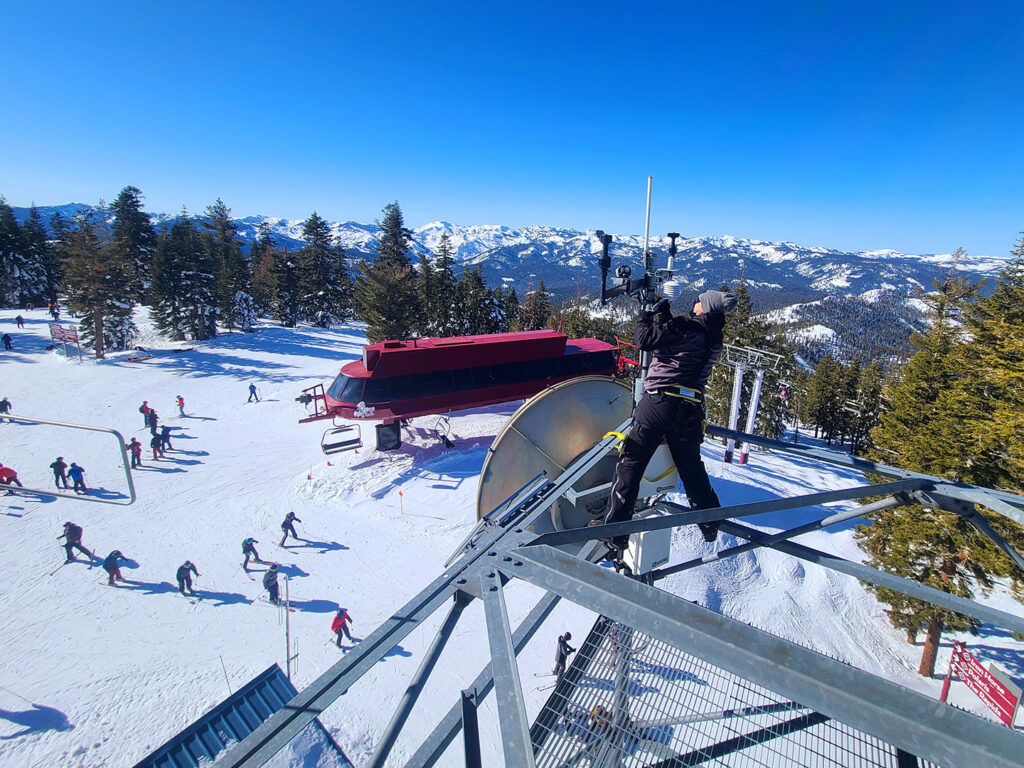
DRI researcher Patrick Melarkey performs maintenance on weather monitoring equipment in the Sierra Nevada Mountains above Lake Tahoe.
The complex science of cloud formation
Cloud formation is a complicated field of research, and scientists are still learning about the way that water droplets and ice crystals interact with atmospheric particles to produce the many different types of clouds we observe. However, one thing is clear: without microscopic particles for water vapor to latch onto — like dust or salt from the sea — clouds cannot form.
Small particles of water scatter in the air and require another speck of something microscopic in order to come together into larger, more visible water droplets. The effect is demonstrated well in a simple video taken in 2008 by scientists in the Arctic, who show that their breath fails to form visible water vapor due to the low atmospheric particle count (at sea, in areas with little to no wind, atmospheric aerosol levels are very low). They then proceed to steep a cup of tea, which also fails to form much of a visible cloud as the tea evaporates into the cold air. But when they spark a lighter over the top, small particles produced during fuel combustion grab onto the surrounding water vapor and a small cloud forms instantly.
Due to this relationship between water vapor and atmospheric aerosols, human activities impact clouds in a number of ways. Atmospheric aerosols now include a wide range of pollutants produced by industrial emissions, tiny bits of plastics and rubber that wear from car tires and brakes, and vehicle tailpipe emissions.
Not all atmospheric aerosols have the same impact on clouds. Research has shown that air pollution can prevent rainfall, because the water droplets in polluted clouds are too small – they float around in the atmosphere without merging to form large enough droplets to fall to the ground. A single drop of precipitation requires more than one million of these small droplets to converge. These pollutants can also prevent ice formation in subfreezing clouds. This means that our everyday activities in urban and industrial areas are already altering global rainfall patterns.
“There’s increasing research showing that air pollution is actually having a negative impact on a cloud’s ability to produce precipitation,” McDonough says. “So, in some ways, we’re trying to restore the cloud’s ability to produce precipitation to what it would have been prior to all the air pollution coming in upstream.”
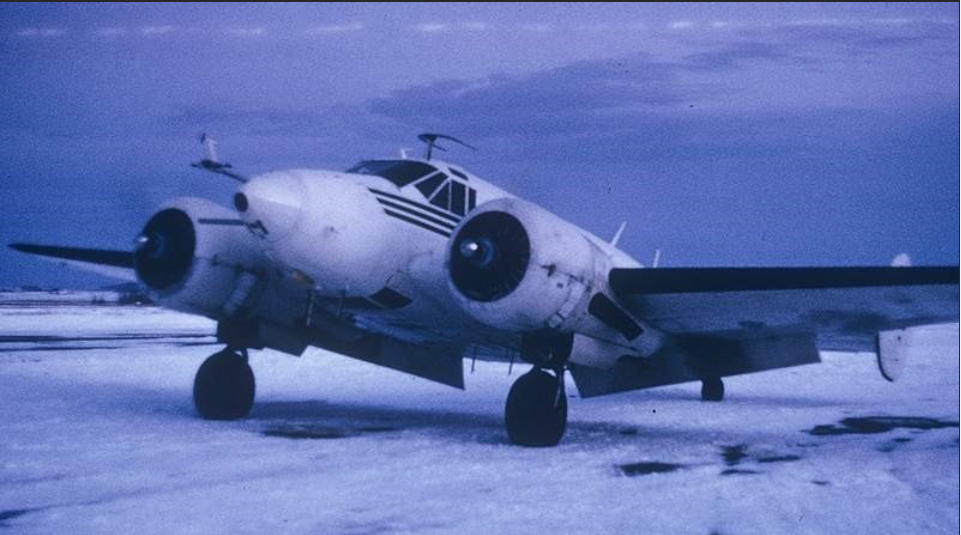
Above: An old Beechcraft C-45 plane that DRI researchers used to seed clouds in 1966. Credit: DRI
A snowstorm in a freezer inspired decades of research
The history of cloud-seeding begins in the 1940’s with scientists who wanted to understand why ice sometimes accumulated on planes, creating dangerous flying conditions. Realizing they needed to know more about clouds that contain supercooled water (which is below freezing temperature but still in liquid form), researchers at General Electric simulated these conditions with a repurposed home freezer, as shown in this video. When they dropped dry ice into the freezer to mix with the water vapor from their own breath, millions of ice crystals formed, simulating a miniature snowstorm. In 1946, one of these scientists was the first to drop dry ice from a plane, watching as streams of snow fell from the cloud.
Following these initial experiments, the research team (including Bernard Vonnegut, brother to famed author, Kurt Vonnegut) turned to silver iodide for its structural similarity to ice crystals. Silver iodide continues to be used today by DRI researchers, as a harmless substance that effectively creates a central point – or nucleus – for water droplets to converge around.
Although many groups around the world continue to use airplanes for cloud-seeding, DRI scientists turned to a ground-based program after a fatal accident on March 2, 1980. The plane crash killed DRI researchers Peter Wagner, William Gaskell, John Latham, and Gordon Wicks. Following this tragic event, one of DRI’s pioneering experts on cloud-seeding, John Hallett, dedicated his expertise on ice formation in clouds to improving airplane safety.
Hallett was recruited in 1966 to be one of the institute’s founding scientists: with his expertise in atmospheric physics, he helped establish DRI as a worldwide leader in the field. His focus on the behavior of ice in the atmosphere led to the discovery of a key mechanism for the transition of water molecules into ice, which is now known as the “Hallett-Mossop ice multiplication mechanism.” DRI continues to be a leader in cloud-seeding efforts and research around the Western U.S.
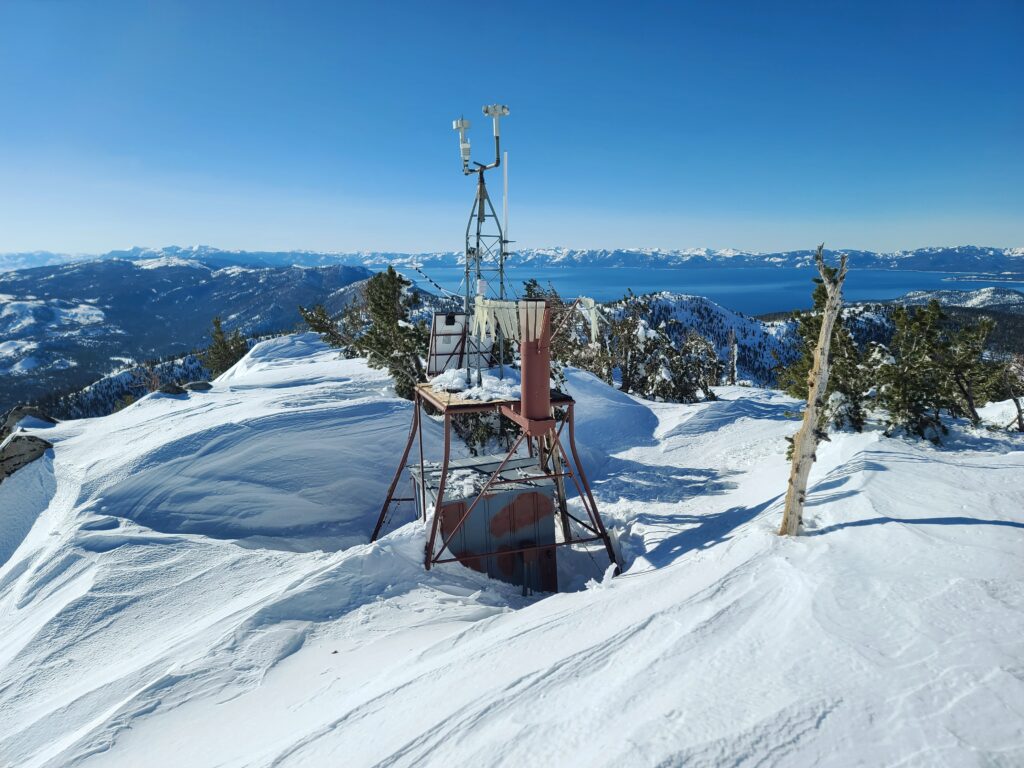
Above: A DRI weather monitoring station perched on top of Slide Mountain overlooking Lake Tahoe. Credit: DRI
Measuring success in the chaos of a storm
Taking cloud-seeding from a freezer to the skies meant finding evidence of the technique’s impact in the real world. Measuring the impact of cloud-seeding attempts isn’t simple, as it requires comparing precipitation from seeded and unseeded clouds under identical conditions – hardly an easy task due to the complex nature of the atmosphere and changing conditions over time. However, scientists have found several ways to assess their impact. By sampling levels of silver iodide in a mountain snowpack following cloud-seeding activities, researchers found it incorporated into ice crystals and deposited as snow – evidence that the compound works as an ice nucleating agent. A comprehensive review of available research published in 2019 concluded “clear physical evidence has been obtained that orographic clouds containing supercooled water, when seeded with silver iodide, produce plumes of ice particles that originate downwind of the seeding location and reach the ground through precipitation growth and fallout.”
In 2020, a ground-breaking study known as the SNOWIE project used advanced radar and cloud-measuring technology to show that cloud-seeding coaxed moisture out of supercooled clouds, producing enough snow to fill 282 Olympic-sized swimming pools over approximately two hours. Studies like this allow scientists to build computer simulations that can facilitate more research, overcoming the difficulty of conducting field experiments under challenging conditions.
Clouds with supercooled liquid water often form around mountain ranges as the air rising over them quickly cools with the elevation change. This is why DRI’s cloud-seeding efforts focus on mountain regions, including the Sierra Nevada and Spring Mountains. A small team of researchers, led by McDonough, plants generators in strategic locations for intercepting incoming storm clouds. These generators vaporize silver iodide particles with acetone, allowing them to rise into the air and enter supercooled clouds. The silver iodide causes the tiny drops of water in the cloud to freeze and go on to grow ice crystals large enough for gravity to pull them to the ground. Ground-based cloud-seeding allows the research team to safely and cost-effectively conduct their work, with each acre-foot of water produced only costing a few dollars.
“There’s been a lot of good research done over the last decade or so that has really nailed down how well this works,” McDonough says. “We’re feeling more and more comfortable about our understanding of when cloud-seeding techniques work, and the scope of the impact.”
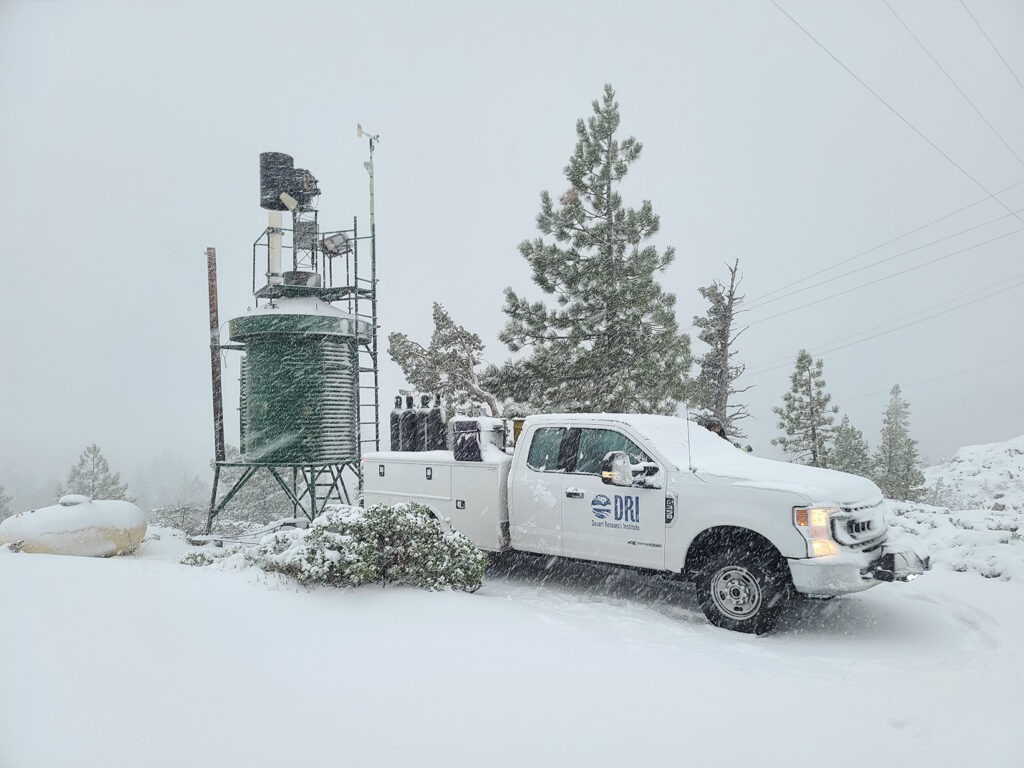
Above: A DRI cloud-seeding generator and maintenance truck in a wintery, mountain-top setting. Credit: Jesse Juchtzer/DRI
Unfortunately, the internet contains many misleading ideas about cloud-seeding. Below is a series of misconceptions and questions about the common scientific practice.
FAQ:
1. Is cloud-seeding producing so-called “chem-trails”?
No. Those fluffy white lines zig-zagging across the sky are jet contrails, and they are the aviation equivalent of visible plumes of steamy breath on a cold morning. Warm water vapor produced during jet fuel combustion interacts with the cold atmospheric air to create strings of ice crystals that behave like high-altitude cirrus clouds. When a plane passes through an area of high pressure, which leads to low winds and clear skies, the trails will linger. Jet contrails have no connection with cloud-seeding activities, and all of DRI’s cloud-seeding occurs from ground generators, not planes.
2. Is cloud-seeding “geoengineering”?
Cloud-seeding is a well-researched and monitored form of small-scale weather enhancement. Other examples of ways that humans change the weather and the global climate include: driving a car, deforestation, and air pollution from industry.
3. Who is funding cloud-seeding programs?
Cloud-seeding programs occur worldwide. In the Western U.S., state and agency-supported efforts occur across California, Nevada, Colorado, New Mexico, Wyoming, Kansas, Oklahoma, Texas, North Dakota, Utah, and Idaho.
4. Is silver iodide toxic?
No. The silver used in cloud-seeding is silver iodide (AgI, or silver bonded to iodine), which can be confused with other molecular forms of silver. When silver is isolated as an ion (Ag+) it is biologically active, meaning it interacts with bacterial or fungal cell walls — which is why it’s often used for medicinal purposes and for sterilizing drinking water. Silver ion (Ag+) can be hazardous in aquatic environments because it can also interact with proteins and other parts of cell membranes, but silver iodide (AgI), not silver ion (Ag+), is used for seeding clouds. Silver iodide retains its form in water and does not break down into the potentially toxic silver ion. When the silver iodide particle falls to the ground with rain or snow, it separates from the water molecules that formed an ice crystal around it, essentially becoming a speck of dust no different from the silver naturally occurring in the soil.
Although the chemistry can be a bit complicated, you can think of it as the difference between water (H2O) – the life-giving force that forms much of your own body – and hydrogen peroxide (H2O2), which is used as a sterilizer and bleaching agent and is hazardous at high concentrations .
5. Is cloud-seeding used for military purposes?
Following the (now declassified) use of cloud-seeding by the U.S. military during the Vietnam War, a 1977 international treaty banned the use of weather modification in warfare.
6. Does DRI continue cloud-seeding during intense winters like the winter of 2022-2023?
DRI pauses all cloud-seeding activities when the snowpack reaches 150% of the historical average. In the Lake Tahoe region, this means that cloud-seeding activities halted in mid-December, 2022, due to the remarkable amount of natural snowfall occurring.
7. Does cloud-seeding have any impact on climate change?
No. DRI’s cloud-seeding program supplements the precipitation in existing storms, which can help alleviate the impacts of drought in targeted areas. It has no impact on the growing amount of greenhouse gases in the atmosphere—these are the direct result of burning fossil fuels to power cars, planes, and power plants.
8. Can cloud-seeding be used to fight wildfires?
Cloud-seeding can only be used to supplement the precipitation in an existing storm. It can’t be used when there are no storm clouds to squeeze additional moisture from, making it impossible to use to fight wildfires that occur during extremely dry conditions. It can, however, be used to alleviate drought conditions, which can help mitigate wildfire risk.
More information:
The Cloud Seeders
A short video about DRI’s cloud-seeding team
Why Cloud Seeding Cannot Make or Control the Weather
ABC News
Where to find more water: eight unconventional resources to tap
The Conversation
By Manzoor Qadir and Vladimir Smakhtin, Deputy Director and Director of the United Nations Institute for Water, Environment, and Health
Can cloud seeding help quench the thirst of the U.S. West?
Yale e360
Wintertime Orographic Cloud Seeding—A Review
Journal of Applied Meteorology and Climatology, Vol. 58, No. 10 (October 2019), pp. 2117-2140
Quantifying snowfall from orographic cloud-seeding
PNAS, Vol. 117, No. 10 (February 2020), pp. 5190-5195
Does cloud seeding really work? An experiment above Idaho suggests humans can turbocharge snowfall
Science Magazine
More Information
To learn more about DRI’s cloud-seeding program, go to https://www-dev.dri.edu/cloud-seeding-program/.
